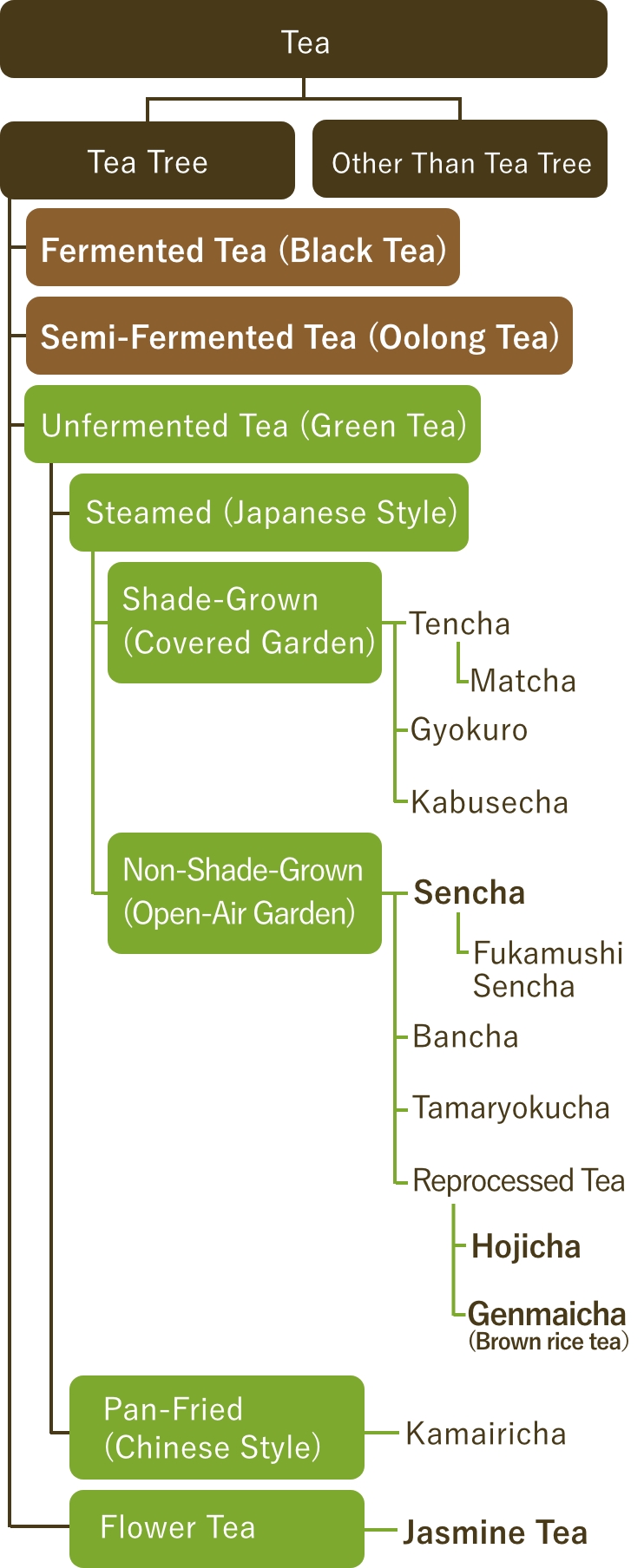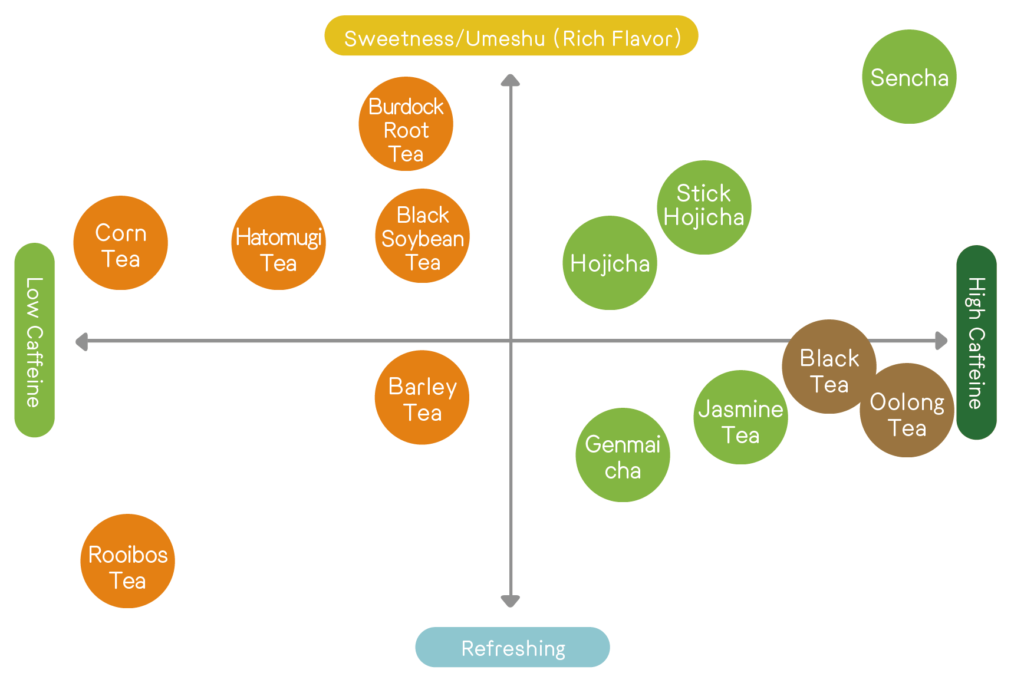We will introduce the types of common teas and their classifications along with a flavor chart.


Tea Flavor Matrix

※Genmaicha Research Institute Study
| Fermented Tea (Black Tea) | Tea leaves contain enzymes, and these enzymes cause the leaves to ferment after harvesting. Fermented tea refers to tea that has been fully oxidized and fermented, with black tea being a representative example. Complete fermentation results in the tea leaves turning dark brown, with a rich aroma and deep flavor. |
| Semi-Fermented Tea (Oolong Tea) | Semi-fermented tea is tea in which some of the tea leaves undergo oxidation and fermentation, with oolong tea being a representative example. The degree of fermentation further categorizes semi-fermented tea. |
| Unfermented Tea (Green Tea) | Unfermented tea involves deactivating enzymes through heat treatment after harvesting, without allowing oxidation and fermentation. Unfermented tea maintains the vibrant green color of the tea leaves and is known for its refreshing aroma and crisp flavor. |
| Flower Tea | A type of Chinese tea in which the fragrance of flower petals is infused into tea leaves, creating flavored tea by mixing dried flower petals with tea leaves. Green tea and oolong tea are commonly used as the base, with jasmine, osmanthus, and lotus being representative flower types. |
| Jasmine Tea | Flower tea that infuses the fragrance of jasmine flowers into green tea or oolong tea. Jasmine tea is a traditional Chinese tea with a long history, dating back several centuries. |
| Steamed (Japanese Style) | Japanese-style green tea minimizes the fermentation (oxidation) of tea leaves through a process of “steaming, rolling, and drying.” This quick heating of the tea leaves preserves their vibrant green color, rich aroma, and crisp flavor. |
| Pan-Fried (Chinese Style) | Chinese-style green tea partially restricts the fermentation (oxidation) of tea leaves through a process of “pan-frying, rolling, and drying.” The longer heating time results in a slightly yellowish-green color of the tea leaves and a strong, robust flavor. |
| Shade-Grown (Covered Garden) | Tea cultivation method involving covering the tea plantation to block sunlight. This minimizes the conversion of theanine (umami component) to catechin (astringent component), resulting in tea leaves with less bitterness and more umami. |
| Non-Shade-Grown (Open-Air Garden) | Tea leaves are naturally grown in full sunlight, leading to the conversion of theanine to catechin and adding a slightly bitter taste, resulting in refreshing tea leaves. |
| Tencha | Tea made by steaming newly grown tea leaves in a covered garden to avoid direct sunlight, then drying them without rolling. Tencha has a rich aroma and a mellow flavor. |
| Matcha | Powdered tea made by grinding tencha or similar tea leaves into a fine powder. It is mainly used in the Japanese tea ceremony and for making matcha-flavored sweets. |
| Gyokuro | The highest-grade tea made by picking tea leaves from a garden covered for about 20 days, similar to sencha, and processed similarly to sencha. It has a unique aroma and a deep flavor, making it popular for tea ceremonies and gifts. |
| Kabusecha | Tea made by covering the tea plantation for approximately 7-14 days before harvesting, and processed similarly to sencha. It combines the freshness of sencha with the flavor of gyokuro. |
| Sencha | Tea made from tea leaves grown in an open-air garden without covering, processed through steaming, rolling, and drying. It is the most commonly consumed green tea, known for its refreshing aroma and refined astringency. |
| Fukamushi Sencha | Similar to sencha in production but with a longer steaming time, more than twice that of regular sencha. The extended steaming reduces leaf size, resulting in less grassy bitterness and a milder taste. |
| Bancha | Tea made from mature or lower-grade tea leaves, stems, or leaves picked between the first, second, or subsequent harvests. It is sometimes referred to as “bancha” from the third harvest onwards. |
| Tamaryokucha | Tea made by drying tea leaves grown under shade in a covered garden for about 20 days, similar to sencha. It has a unique aroma and deep flavor, making it popular for tea ceremonies and gifts. |
| Kamairi-sei Gyokuro Tea | Tea finished by roasting the leaves in a pot instead of the steaming process used for sencha. Due to the absence of the rolling process, the tea leaves have a round, curled shape. Roasting brings out a unique flavor and rich aroma. |
| Reprocessed Tea | Tea that has undergone further processing beyond the finishing stage. Representative examples include hojicha and genmaicha. |
| Hojicha | Tea made by roasting sencha or bancha over high heat to enhance its aroma. Roasting changes the composition and flavor of the leaves, resulting in a unique taste. |
| Genmaicha(Genmaicha) | A mixed tea that includes roasted rice added to sencha or bancha. It features the refreshing taste of green tea combined with the aroma and flavor of roasted rice. |
| Barley Tea | Tea made by steeping roasted barley in hot water or cold water. It is known for its toasty aroma and is a popular beverage in Japan, especially during the summer. It is caffeine-free and often enjoyed as a non-caffeinated option or for children. |
| Hatomugi Tea | Tea made by roasting hulled Job’s tears. Hatomugi is believed to have health and beauty benefits, making it a popular choice for health-conscious tea drinkers. |
| Corn Tea | Tea made by steeping roasted corn in hot water. It is also known as maize tea and is enjoyed in Korea for its non-caffeinated nature and subtle sweetness. |
| Black Soybean Tea | Tea made by steeping roasted black soybeans in hot water. It is characterized by the fragrance of black soybeans and a subtle sweetness. It is sometimes blended with other ingredients. |
| Burdock Root Tea | Tea made by steeping cleaned, cut, dried, and roasted burdock root. Burdock root is rich in soluble dietary fiber, making it a popular choice for health-conscious individuals. |
| Rooibos Tea | Tea made from the leaves of the ‘Rooibos’ plant cultivated in South Africa. Rooibos tea has a unique flavor profile and is popular as a caffeine-free, health-promoting tea.” |

